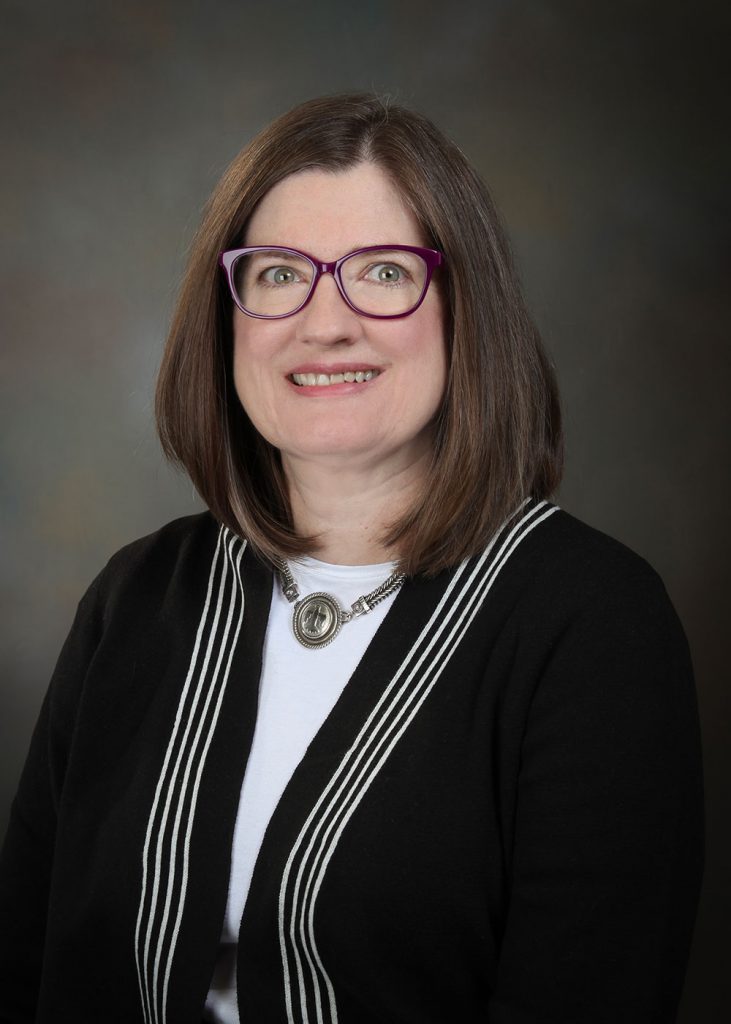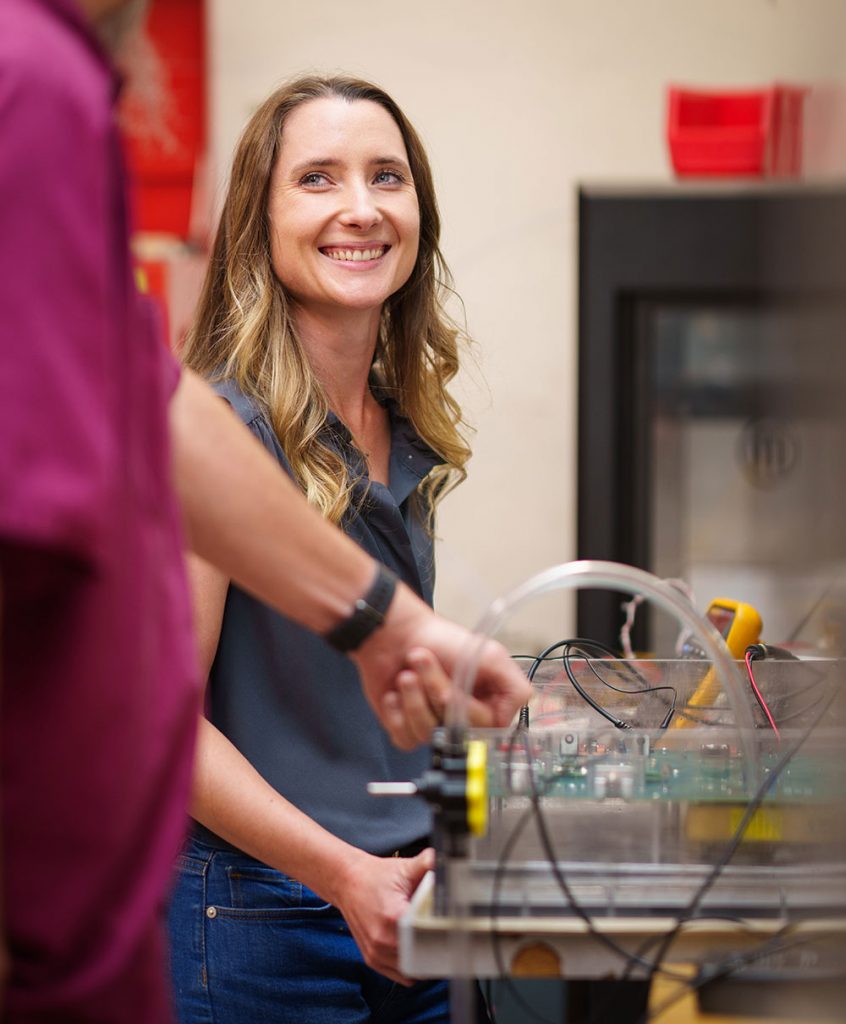Different paths lead to two individual awards; patents abound
Women engineers at Sandia achieved significant recognition from the 2023 Society of Women Engineers. These accolades included Distinguished New Engineer, Advocating Women in Engineering and 10 patent recognition awards.
The society’s awards program celebrates high levels of achievement among individuals who identify as women and allies in engineering, engineering technology or science related to engineering at all career stages.
Leslie Phinney — Advocating Women in Engineering

Leslie is the manager of Sandia’s Thermal Sciences and Engineering Department, where she has worked since August 2015. “I arrived at Sandia in 2003 as an experimentalist qualitatively examining laser interactions and the heating of polycrystalline silicon microdevices,” she said. “Over the years, that work progressed into developing modeling and computations for improved diagnostic techniques to quantify the temperatures of the materials.
“Now I’m a manager,” Leslie said. “So, I meet with staff, marshal resources and approve all the things that need to be approved. I’m also a program manager for several advanced simulation and computing projects. I don’t do modeling and simulation myself, but I get to support others and then report on the great work that they do.”
Leslie grew up in a family of generations of teachers. “My parents both have master’s degrees. My great-grandfather was a teacher in Indiana and really believed in education for women, which at the time wasn’t common,” she said. “I also had a great aunt who graduated in the late 1920s with a university degree in math, which was pretty unusual at the time. It took her 10 years to get a job teaching due to the Great Depression and only after men began enlisting for service in World War II.”
Math quickly became Leslie’s passion in school but astronaut Sally Ride, the first American woman to fly in space, was her inspiration. She locked into aerospace engineering as her college major at the University of Texas, where she enjoyed fluid mechanics and heat transfer courses. “That directed me more towards mechanical engineering,” she said. Leslie went on to earn her master’s degree and doctorate in mechanical engineering.
As she delved deeper into her engineering pursuits, Leslie noticed the ranks of women dwindling. “While earning my degrees, there were fewer women as I went along,” she said. “I knew I was a minority, but I didn’t feel like a minority because I was supported.”
After receiving her doctorate in mechanical engineering at the University of California, Berkeley, in 1997, Leslie joined the mechanical and industrial engineering department at a Midwest university as a junior faculty member. “I was the first woman mechanical engineering professor hired at the university and one of two women in a department of 50,” Leslie said. “It was a bit of an isolating experience.”
Six years later, Leslie moved from academia to Sandia in 2003 as a technical staff member and is now a department manager, a position she has held since September 2020.
Leslie’s life experiences — support from her family, fellow students, colleagues and friends — have compelled her to improve the engineering journey for those who follow.
“My true desire at this point in my career is to make things better for those who are coming after me,” she said. “I see engineering as a good career choice for everyone, and I don’t want anyone to be excluded from the opportunities that are available.”
And she’s been busy over the years encouraging young people, especially young women, to pursue engineering by establishing scholarships for women in engineering and mentoring engineering students through numerous professional and technical societies. Leslie provides leadership and activities for the Sandia Women’s Action Network, the American Society of Mechanical Engineers and the Society of Women Engineers. She also engages in local K-12 outreach activities that expand the concepts and appeal of engineering.
“I’ve often heard the phrase, ‘You can’t be what you can’t see,’ so over the years I’ve tried to empower women engineers to be visible and involved in their communities,” Leslie said. Part of her core mission is her belief in the potency of diversity. “Having people from different fields of study, life experiences, cultures and beliefs boosts creativity and innovation, versus a more homogeneous team that is likely to fall into groupthink. Engineers are in the business of solving difficult problems, and we need the best people and most innovative teams to solve them.”
About the award
“I see this award as meaningful recognition that I’m trying to make an impact. I think there’s still more work to be done.”
Advice for aspiring women engineers
“Be persistent. Engineering takes a long, sustained academic and professional effort. If you’re looking for an easy college major or career, take engineering off your list.”
Emily Schrock — Distinguished New Engineer

Emily is an electrical engineer conducting experimental lab work with various pulse-power systems. She performs modeling designs and diagnostics for both the systems and their components.
Emily’s interest in engineering sparked at an early age visiting job sites with her dad, who is an electrical engineer in Texas where Emily grew up. “My dad always had a big hand in the electrical work as a project manager for the design and construction of buildings,” Emily said. “We would walk through the sites and talk about electrical and mechanical designs and functions. Getting to see the actual application of electrical engineering growing up really got me interested.”
As a teenager, Emily’s interest and aptitude in math and science cleared a path toward physics where she was drawn to the electrical and magnetism disciplines. “When it came time to declare a major in college, I chose electrical engineering and I absolutely loved it,” she said. “I had a great group of friends, and we took the same classes together. That support group helped but it wasn’t easy. I remember a good number of all-nighters.”
Emily earned her master’s degree in electrical engineering from Texas Tech University in 2017, the same year her then fiancé was stationed at Kirtland Air Force Base in Albuquerque. Through a Tech alumnus, she learned of an opening at Sandia for an electrical engineer with pulse-power experience and a semiconductor background — work she had performed in college. She hired on at the Labs in 2017 as a research and development science and engineering microwave and sensor engineer.
“I’ve been able to do some very cool things here at Sandia,” Emily said. “What I really like is building and then field-testing system hardware. Over the years, I’ve enjoyed being able to test our design work and experience its success in the field.”
About the award
“It’s really special because I was up against such a variety of people from major technology companies doing great things in their fields with backgrounds so different from mine.”
Advice for aspiring women engineers
“If you want to be an engineer or physicist, don’t let anything stand in your way. If you start feeling you don’t belong, take advantage of the outreach available to you and find a mentor who will cheer you on. Don’t allow others to choose your career path when you could make a big difference in an engineering realm.”
Society of Women Engineers Patent Recognition Awards
The following engineers received the SWE Patent Recognition Awards:
Laura Biederman, research and development science and engineering in electronic, optical and nanomaterials. System and Method for Cooling Using a Heat Exchanger Having a Membrane and Filtration Membranes.
Suma Cardwell, research and development science and engineering in computer science. Spiking Retina Microscope.
Gabriella Dalton, research and development science and engineering in optical engineering. Calibration Method for a Spectral Computerized Tomography System.
Katharine Harrison, former Sandia employee in nanoscale sciences. Nanoporous Carbon as an Anode Material for Li-ion Batteries; and Nanoporous Carbon as a Host for Sodium.
Nadine Miner, research and development science and engineering manager in advanced science and technology, University of Texas partnerships. Methods, Systems and Computer Program Products for Determining Systems Re-Tasking.
Stacy Nelson, research and development science and engineering in materials and failure modeling. Enhanced Composites Via Selective Interfacial Modification.
Karla Reyes, research and development science and engineering manager in materials chemistry. Apparatus, Methods and System for Temperature Gradient Aging with In-Situ Electrical Monitoring; and Thermal Measurement Apparatus and Methods for Anisotropic Thermal Materials.
Dorina Sava Gallis, research and development science and engineering in nanoscale sciences. Degradation of Chemical Agents Using Metal-Organic Frameworks Compositions; Tunable Metal-Organic Framework Compositions and Methods Thereof; and Compositions, Systems and Methods for Selective Porous Material Oxygen Separation.
Heidi Smartt, research and development science and engineering in international safeguards and engagements. Non-Contact Rapid Reader System for Reflective Particle Tags and two for Fluorescent Compositions.
Erika Vreeland, research and development science and engineering in aerosol science. Micro-lensed Fiber Optic Plate; and Magnetic Needle Separation and Optical Monitoring.
The Society of Women Engineers, founded in 1950, is a not-for-profit educational and service organization that empowers women to achieve their full potential in careers as engineers and leaders.